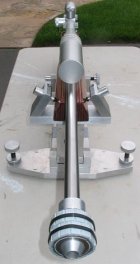TRSR8
Silver $$ Contributor
Likely, your point has zero to do with anything to do with air turbulence. All of the best IR sporters exhibit that format, usually a good inch plus, and often shoot as good as the heavy guns.Threading a barrel (especially a button or cut rifled barrel) can / will cause the bore to open up at the treaded section. Normally it only a few ten thousandths of an inch (0.000x), but this is enough to effect the accuracy potential of that barrel. This isn’t to say that you will not end up with a phenomenal barrel, it just isn’t optimal (same size bore to the muzzle or maybe a slight choke). I know this because I have measured it several times and have had sev other very reputable gunsmiths agree.
One thing I dont know about is a hammer forged barrel. Robert Heart told me many many years ago that stress from the rifling process is imparted in the metal. Button & cut barrels have stress that is going away f the bore center line, & hammer forged barrels have stress that is going toward the bore centerline. So possibly hammer forged barrels may have a tendency to tighten up when threaded. But I have never tested that.
For counterboring, I have seen counter bored barrels shoot better after the counter bore is cut off. Not significantly but noticeable. What I don’t know is if this is due to a harmonic change with weight removal (I kind of doubt it because it is such a small amount of weight, but maybe) or because the bullet is entering cleaner (less turbulent) air with out that fairly tight tunnel to fly through. Hard to say either way because I have seen excellent accuracy with rimfires running bloop tubes, but they are significantly longer than a back bored muzzle.
It is all interesting stuff, just hard to scientifically prove anything because barrels are so unique.
I’d guess it likely has more to do with re acquisition of new tune after change.














